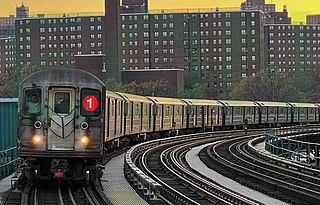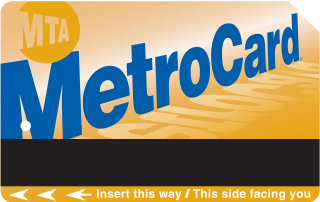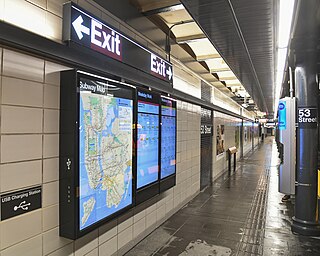
The New York City Subway is a rapid transit system in the New York City boroughs of Manhattan, Brooklyn, Queens, and the Bronx. It is owned by the government of New York City and leased to the New York City Transit Authority, an affiliate agency of the state-run Metropolitan Transportation Authority (MTA). Opened on October 27, 1904, the New York City Subway is one of the world's oldest public transit systems, one of the most-used, and the one with the most stations, with 472 stations in operation.

Metro-North Railroad, trading as MTA Metro-North Railroad, is a suburban commuter rail service operated by the Metropolitan Transportation Authority (MTA), a public authority of the U.S. state of New York. Metro-North serves the New York Metropolitan Area, running service between New York City and its northern suburbs in New York and Connecticut, including Port Jervis, Spring Valley, Poughkeepsie, Yonkers, New Rochelle, Mount Vernon, White Plains, Southeast and Wassaic in New York and Stamford, New Canaan, Danbury, Bridgeport, Waterbury, and New Haven in Connecticut. Service in Connecticut is operated under contract with the Connecticut Department of Transportation. Metro-North also provides local rail service within the New York City boroughs of Manhattan and the Bronx.

The New York City Transit Authority is a public-benefit corporation in the U.S. state of New York that operates public transportation in New York City. Part of the Metropolitan Transportation Authority, the busiest and largest transit system in North America, the NYCTA has a daily ridership of 8 million trips.

The MetroCard is a magnetic stripe card used for fare payment on transportation in the New York City area. It is a payment method for the New York City Subway, New York City Transit buses and MTA buses. The MetroCard is also accepted by several partner agencies: Nassau Inter-County Express (NICE), the PATH train system, the Roosevelt Island Tramway, AirTrain JFK, and Westchester County's Bee-Line Bus System.

The Metropolitan Transportation Authority (MTA) is a public benefit corporation responsible for public transportation in the New York City metropolitan area of the U.S. state of New York. The MTA is the largest public transit authority in North America, serving 12 counties in Downstate New York, along with two counties in southwestern Connecticut under contract to the Connecticut Department of Transportation, carrying over 11 million passengers on an average weekday systemwide, and over 850,000 vehicles on its seven toll bridges and two tunnels per weekday.
The MTA Regional Bus Operations bus fleet is a fleet of buses in fixed-route service in New York City under the "MTA New York City Bus" and "MTA Bus" brands, both of which operate local, limited, express and Select Bus Service routes.

A passenger information system, or passenger information display system, is an automated system for supplying users of public transport with information about the nature and the state of a public transport service through visual, voice or other media. It is also known as a customer information system or an operational information system. Among the information provided by such systems, a distinction can be drawn between:

The fares for services operated under the brands of MTA Regional Bus, New York City Subway, Staten Island Railway (SIR), PATH, Roosevelt Island Tramway, AirTrain JFK, NYC Ferry, and the suburban bus operators Nassau Inter-County Express (NICE) and Westchester County Bee-Line System (Bee-Line) are listed below.

The R160 is a class of New Technology Train subway cars built for the New York City Subway's B Division. Entering service between 2006 and 2010, they replaced all R38, R40, and NYCT-operated R44 cars, and most R32 and R42 cars. The R160s are very similar to the earlier R143s and later R179s. The biggest difference between the R160 and R143 is the Flexible Information and Notice Display (FIND) system on the R160s in place of static LED maps on the R143s and all A-Division New Technology fleet.

Select Bus Service is a brand used by the Metropolitan Transportation Authority (MTA)'s Regional Bus Operations for limited-stop bus routes with some bus rapid transit features in New York City. The first SBS route was implemented in 2008 to improve speed and reliability on long, busy corridors.

MTA Regional Bus Operations (RBO) is the surface transit division of the Metropolitan Transportation Authority (MTA). It was created in 2008 to consolidate all bus operations in New York City operated by the MTA. As of February 2018, MTA Regional Bus Operations runs 234 local routes, 71 express routes, and 20 Select Bus Service routes. Its fleet of 5,840 buses is the largest municipal bus fleet in the United States and operates 24/7. In 2023, the system had a ridership of 730,924,600, or about 2,309,600 per weekday as of the fourth quarter of 2023.
Titan was an American advertising firm that specialized in out-of-home advertising, headquartered in New York City, New York. A privately held company, it was the largest transit advertising company in North America until a 2015 merger. The company provided services for outdoor advertising on transit vehicles and stations, telephone kiosks, and street banners.
Control Group was a technology and design consultancy firm, founded in 2001 in Lower Manhattan, New York City, by Campbell Hyers, Scott Anderson, and Colin O'Donnell.

Many transit maps for the New York City Subway have been designed since the subway's inception in 1904. Because the subway was originally built by three separate companies, an official map for all subway lines was not created until 1940, when the three companies were consolidated under a single operator. Since then, the official map has undergone several complete revisions, with intervening periods of comparative stability.

LinkNYC is an infrastructure project providing free Wi-Fi service in New York City. The office of New York City Mayor Bill de Blasio announced the plan on November 17, 2014, and the installation of the first kiosks, or "Links," started in late 2015. The Links replace the city's network of 9,000 to 13,000 payphones, a contract for which expired in October 2014. The LinkNYC kiosks were devised after the government of New York City held several competitions to replace the payphone system. The most recent competition, in 2014, resulted in the contract being awarded to the CityBridge consortium, which comprises Qualcomm; Titan and Control Group, which now make up Intersection; and Comark.

MTA Bus Time, stylized as BusTime, is a Service Interface for Real Time Information, automatic vehicle location (AVL), and passenger information system provided by the Metropolitan Transportation Authority (MTA) of New York City for customers of its bus operations under the New York City Bus and MTA Bus Company brands. First tested in late 2010 and officially launched in early 2011, MTA Bus Time was installed in all MTA bus routes in New York City by 2014.
LinkUK or InLinkUK is an infrastructure project that planned to cover major cities in the United Kingdom with free Wi-Fi service. LinkUK kiosks, called Links, was initially rolled out in the London borough of Camden in 2017, and later in Lambeth, Hammersmith & Fulham and other boroughs. Afterwards, it was intended that Links would be installed in the remainder of Greater London and eventually across major cities in the UK. LinkUK is an expansion of the LinkNYC project covering New York City with free Wi-Fi service.

Since the late 20th century, the Metropolitan Transportation Authority has started several projects to maintain and improve the New York City Subway. Some of these projects, such as subway line automation, proposed platform screen doors, the FASTRACK maintenance program, and infrastructural improvements proposed in 2015–2019 Capital Program, contribute toward improving the system's efficiency. Others, such as train-arrival "countdown clocks", "Help Point" station intercoms, "On the Go! Travel Station" passenger kiosks, wireless and cellular network connections in stations, MetroCard fare payment alternatives, and digital ads, are meant to benefit individual passengers. Yet others, including the various methods of subway construction, do not directly impact the passenger interface, but are used to make subway operations efficient.
OMNY is a contactless fare payment system, currently being implemented for use on public transit in the New York metropolitan area. OMNY can currently be used to pay fares at all New York City Subway and Staten Island Railway stations, on all MTA buses, AirTrain JFK, Metro North's Hudson Rail Link, and on the Roosevelt Island Tram; when completely rolled out, it will also replace the MetroCard on Bee-Line buses, and NICE buses. OMNY will also expand beyond the current scope of the MetroCard to include the Long Island Rail Road and Metro-North Railroad.

MYmta is a mobile application-based passenger information display system developed by the Metropolitan Transportation Authority (MTA) of New York City. A beta version of the app was launched on July 2, 2018, and as of June 2019 is still undergoing beta testing. While other applications exist which serve similar functions, MYmta is an all-in-one source for data provided directly by the MTA.














